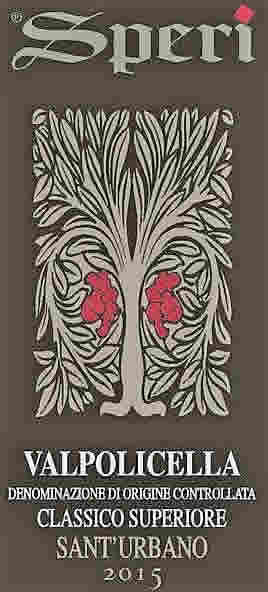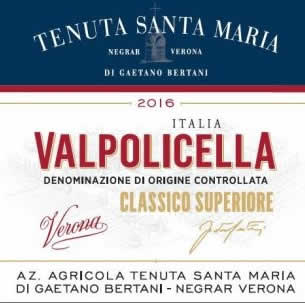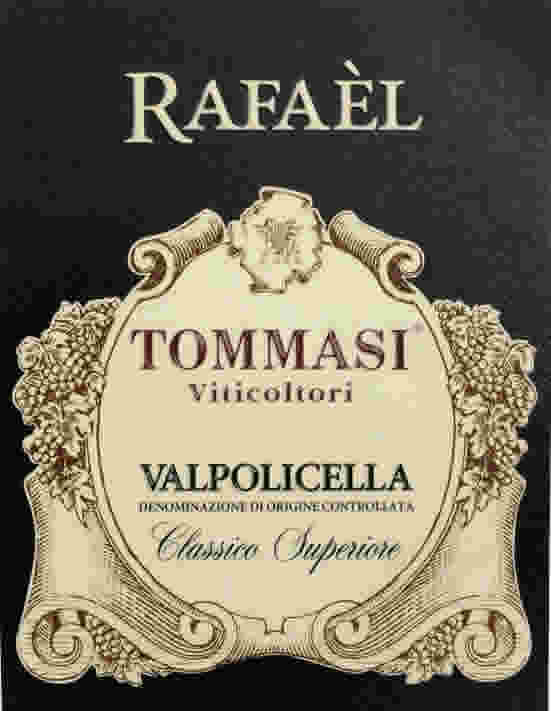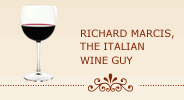Valpolicella Superiore Wines: A Step-up in Quality
Valpolicella is the most important red wine in the Veneto region in northeastern Italy and it’s likely that most wine drinkers have at some point sampled one of the Valpolicella wines.
A variety of wine styles is produced under the “Valpolicella” label that includes “basic” Valpolicella; Valpolicella Superiore; Valpolicella Ripasso; Valpolicella’s “big brother” Amarone della Valpolicella; and the sweet, dessert-style Recioto della Valpolicella.
While the wines vary markedly in terms of style and structure, they all are blended wines that utilize the same basic combination of grapes. The thick-skinned Corvina is the most important variety in the blend and generally comprises the lions’ share of the blend along with some aromatic Rondinella and measured doses of Molinara. Some producers substitute modest amounts of other local varieties like Corvinone, Croatina or Oseletta in the blend.
The basic Valpolicella is probably what most people talk about when they talk about Valpolicella. It typically is fermented and aged for a short period in steel tanks and released a few months after the grape harvest. While a few producers have explored barrel-ageing of Valpolicella, this ageing regimen is not a common practice for basic Valpolicella.
At its best, Valpolicella is a light, fragrant wine with pleasantly fruity flavors, a pleasant touch of acidity and modest tannins. Unfortunately, the most commonly available Valpolicella wines are produced by large commercial bottlers or cooperatives that market inexpensive, uninspired Valpolicella for every-day drinking. And as long as there is a demand for it they'll continue supplying it.
Wines labeled Valpolicella Classico are produced from grapes grown in designated terraced vineyards in the historic center of the Valpolicella region. Some are produced by quality-conscious family-owned wineries and can be a step-up in quality from the basic Valpolicella wines from outside the classico zone. The wines can be richer and more flavor intensive than basic Valpolicella and, as such, are good companions for Italian antipasti, risotto, cured meats, light pasta dishes and pizza.
Wines labelled Valpolicella Superiore are very different from regular Valpolicella and Valpolicella Classico. The Superiore designation indicates that the wine has been aged for at least one year in wood and has a minimum alcohol level of 12 percent. Some producers even age their Superiore wines in small 225-liter barriques but the practice is not widespread and most use larger casks or a combination of the two in order to preserve Valpolicella’s delicate bouquet and fruity flavors.
The minimum one-year wood ageing requirement as well as the riper grapes required to achieve the minimum 12 percent alcohol content impart a darker hue, greater structure and rich red berry flavors to the wine thereby creating a more complex and intriguing wine. Valpolicella Superiore wines will generally have more prominent bouquets and evolved flavors and greater texture than regular Valpolicella.
Superiore wines are also the most versatile of the Valpolicella family of wines. Producers have considerable latitude in how they craft their Superiore wines. Some producers may use late-harvested or partially-dried grapes via the appassimento process for a rounder, more velvety wine with some added alcohol. Some producers may age their wines in small barriques to add tannins and enhance flavors while others may opt for larger, less-intrusive, casks.
Still others may utilize the Ripasso technique whereby the finished Valpolicella wine is “passed over” the drained but still fermenting pomace (grape skins, seeds and pulp) left over from the fermentation of the producer's Amarone wine. This induces a second fermentation that adds additional richness and depth to the "repassed" Valpolicella Superiore.
The end result is a wine that retains the vibrancy of Valpolicella but is even darker in color, bigger and more flavorful and complex than the original Valpolicella Superiore. It’s a wine with sufficient stuffing to go with hearty foods such as stews, grilled or roasted red meats and aged cheeses. Some producers will indicate that the Ripasso technique was used by adding the word “Ripasso” on the wine label while others may omit the label designation.
Thus, not only are the Superiore versions a step-up in quality from basic Valpolicella, there is also a diverse array of styles of Superiore wines that depends on individual producers’ approaches to crafting their version of Valpolicella Superiore. Additionally, Valpolicella Superiore wines are not much more expensive than basic Valpolicella, generally ranging from $20 to $35.
The following selection of 10 Valpolicella Superiore wines highlights the quality of the Valpolicella Superiore designation as well as the diversity of styles within the designation. Some wines may be harder to find than others but all are generally available in major U.S. markets.
Buglioni, “l’Imperfetto” Valpolicella Classico Superiore 2014 (about $21)
This elegant Valpolicella Superiore from the Classico zone is aged in oak casks for 8 months with 6 additional months in the bottle prior to release. This wine is medium-to-full bodied but softly textured with velvety dark fruit flavors and a flavorful finish accented with some sweet spice notes.
Corte Sant'Alda “Mithas” Valpolicella Superiore 2004 (about $39)
This cru wine is one of the richer and more robust versions of Valpolicella Superiore. The grapes are ultra-ripe when harvested in late October and undergo fermentation in wood casks for two weeks. The wine is then aged in oak casks for 2 years before bottling. It’s a big wine loaded with plush, Amarone-like juicy dark fruit flavors and soft tannins balanced with good acidity. It’s a pleasure to drink with a second glass impossible to resist.
Giuseppe Quintarelli, Valpolicella Classico Superiore 2010 (about $98)
The Giuseppe Quintarelli estate is known for its deep, complex and long-aged wines bottled with distinctive handwritten labels. Although the legendary Giuseppe Quintarelli died in 2012 at age 84 the winery remains family-owned and managed and they keep a close watch over the estate’s legacy.
The grapes for the 2010 Valpolicella Classico Superiore are carefully hand-selected and undergo the traditional Ripasso process whereby a second fermentation takes place on the pomace of the recently-fermented Amarone. The wine is then aged for 7 years in large Slavonian oak casks before bottling, an amazing period for ageing but consistent with the maestro’s proclamation that wines will only be released at their optimum maturities and not a moment before.
It is a substantial, layered and complex wine with an invigorating 15 percent alcohol content. This “baby Amarone” has enticing aromas of ripe black cherry, spices and subtle cedar notes with blackberry and raisiny dried-fruit flavors. The mouthfeel is full, rich, intense and structured and capped by a long, flavorful finish.
Quintarelli wines are critically acclaimed around the world and all carry eye-popping price tags to match. While expensive, Quintarelli’s Valpolicella Classico Superior is probably the least expensive wine in the Quintarelli portfolio and as such does give us mere mortals a chance to experience the grandeur of a Quintarelli wine without paying a king’s ransom to do so.
Marchesi Fumanelli, Valpolicella Classico Superiore 2014 (about $24)
With 78 acres under vine the Marchesi Fumanelli estate is one of the larger family-owned wineries in the Valpolicella zone. It also is one of the area’s most historic wineries with a grape-growing and wine-making history stretching back to 1470, an amazing 28 generations.
Their 2014 Valpolicella Classico Superiore is a blend of estate-grown Corvina, Corvinone and Rondinella grapes aged for 10 months in French oak barriques with 3 additional months in the bottle. The wine is made in the rich, smooth style with ripe cherry and dark fruit flavors, silky texture and a long, lingering finish.
Speri, “Sant’Urbano” Valpolicella Classico Superiore 2015 (about $35)
The “Sant’Urbano” Valpolicella Classico Superiore is made  fully-ripe grapes that are left to partially dry before fermentation. After 3 weeks the partially-dried grapes are pressed and the juice left to ferment with the grape skins in steel tanks after which the wine is racked and then aged in Allier oak vats for 18 months
fully-ripe grapes that are left to partially dry before fermentation. After 3 weeks the partially-dried grapes are pressed and the juice left to ferment with the grape skins in steel tanks after which the wine is racked and then aged in Allier oak vats for 18 months
The appassimento process the Sant’Urbano Valpolicella Superiore undergoes, albeit brief, produces a substantial, layered and complex wine with ripe cherry and sweet spice aromas and dark fruit flavors. It is a well-balanced wine with distinct tannins and plenty of grip with good ageing potential.
Tedeschi, “Maternigo” Valpolicella Superior 2011 (about $27)
Founded in 1824, the Tedeschi winery has remained family-owned and today is owned and managed by the 5th generation of the Tedeschi family.
This full-bodied wine is aged in large Slavonian oak casks for 14 months and spends an additional 6 month in the bottle prior to release. It is well-structured, complex and rich with dark fruit flavors, firm tannins and pleasant notes of dried herb that linger on the long finish. It has 14 percent alcohol and good ageing potential.
Tenuta Santa Maria, Valpolicella Classico Superiore 2016 (about $23)
This Valpolicella Superiore is produced with th e traditional Valpolicella varietals grown in low-yield vineyards at the Santa Maria estate in the historic Classico zone around Verona. After a long maceration and fermentation, the wine is aged for 12 months in traditional large oak casks followed by a few months in the bottle prior to release.
e traditional Valpolicella varietals grown in low-yield vineyards at the Santa Maria estate in the historic Classico zone around Verona. After a long maceration and fermentation, the wine is aged for 12 months in traditional large oak casks followed by a few months in the bottle prior to release.
This mid-weight wine is round and soft, loaded with red fruit flavors and nicely balanced with soft tannins and vibrant acidity.
Tommasi, “Rafaèl” Valpolicella Classico Superiore 2016 (about $20)
This Valpolicella is produced from grapes grown in Tommasi ’s historic Rafaèl vineyard in the Valpolicella Classico zone. The traditional Valpolicella combination of  varieties is fermented and then aged for 15 months in large oak casks.
varieties is fermented and then aged for 15 months in large oak casks.
This medium-weight wine from one of Valpolicella’s best producers has an enveloping bouquet of red fruits and aromatic herbs that follow through in the flavor profile. It has good acidity and structure with some spice notes that give a pleasing lift to the dry finish.
Tommaso, “Bussola” Valpolicella Classico Superiore TB 2013 (about $39)
The Tommaso winery makes two classes of wine – BG is the standard tier while TB is the top tier, reserved for what the estate considers its very best wines.
The 2013 “Bussola” Valpolicella Classico Superiore TB is a blockbuster wine. It is made in the Ripasso style with the wine undergoing a second fermentation on the pomace of the spent Amarone for a week. The wine is aged for 18 months in a combination of 500-liter French oak barrels and smaller barriques followed by 3 months in the bottle.
It is a big and generous wine with ripe black fruit flavors, a velvety texture, rich tannins and 15.5 percent alcohol all of which make it an ideal companion for equally-weighty dishes such as grilled or roasted beef, lamb, game or aged cheeses.
Zyme, Valpolicella Superiore DOCG 2015 (about $26)
The 72-acre Zyme winery is located in the town of San Pietro in Cariano in the heart of the Valpolicella Classico zone. Founded in 2003, the Zyme winery is by Veneto standards a relatively recent addition to the wine scene.
The grapes are harvested and fermented in September to mid-October and in January undergo a second fermentation on the leftover grape skins, seeds and pulp of their recently fermented Amarone in accord with the classic Ripasso tradition. Zyme’s Valpolicella Superiore is then aged in oval-shaped oak casks for 2 years and then 6 months in the bottle prior to release. It has 14 percent alcohol.
It has ripe cherry and plum flavors, a velvety texture, medium-to-full body and capped with a long, pleasant finish.
©Richard Marcis
June 15, 2019
Return to Wine Reviews and Musings
Return to italian wine reviews
Help keep this website ad-free and independent.
Consider making a contribution to support the work of WineWordsWisdom.com.


